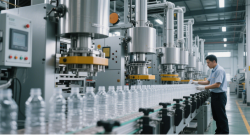The Future Of PET Preforms: Trend Shaping The Beverage Industry Landscape
The Future Of PET Preforms: Trends Shaping The Beverage Industry Landscape
Reducing production expenses for PET preforms while upholding quality standards is a key strategy for boosting company profits. This principle holds true in the beverage industry, especially among manufacturers of PET preforms that convert them into bottles for soft drinks, alcoholic beverages, and other liquid foods.
It's essential to stay attuned to shifts in consumer preferences and market trends, including seasonal variations that can impact sales. To remain competitive, companies should evaluate emerging trends and refine their processes accordingly. Here’s how to approach this.

Evaluating the Life Cycle of Preforms in Virgin and Recycled PET
Focusing on mold quality is paramount. Collaborating with a partner capable of designing and producing customized, high-quality injection and blow molds ensures consistent production with minimal issues, ultimately lowering maintenance costs and the need for spare parts.
The journey begins with material selection. The steel and aluminum used in mold manufacturing must possess outstanding qualities to withstand millions of production cycles without succumbing to wear. A durable mold leads to ongoing profitability that can quickly recoup initial investments and continue generating revenue.
Moreover, advanced design and planning of cooling channels are crucial in optimizing the speed of preform production and conserving water usage.
Innovations in PET Design and Lightweighting
Lightweighting PET preforms is a vital aspect of cost reduction; however, it’s crucial that these lighter bottles still meet the requirements for palletization, transportation, and consumer satisfaction. Achieving this necessitates a detailed design phase conducted by industry experts who can determine the optimal characteristics for the containers while minimizing material use.
Only after thorough analysis and prototyping can molds be developed that are ideally suited to a company's specific production requirements.
Injection Molds Tailored for Versatile Production
By starting with an intelligent preform design, it's possible to create injection molds that can adapt to varying production demands. For instance, if there's a need to adjust the weight of the preform, it should be as simple as swapping out the core rather than replacing the entire mold. This approach can lead to significant savings in both time and costs.
This flexibility in PET preform production is especially important during peak demand periods, such as summer, when bottlers experience heightened activity. Companies that don’t maintain large stocks of preforms year-round may need to invest in molds that are appropriately sized or even larger than those used by blowers to avoid downtime.
Lower Environmental Impact: Cost and Emission Savings
The packaging industry is increasingly gravitating towards environmentally friendly solutions, which not only benefit the planet but also contribute to cost reductions. Utilizing machines that consume less energy and molds that require less water results in substantial savings related to CO2 emissions and natural resource usage.
Transitioning to recycled PET (R-PET) is another growing trend, offering both ecological advantages and economic benefits. For example, at the Packaging & Recycling Forum 2019, Ferrarelle highlighted how using R-PET at its facility in Presenzano (CE) yielded impressive results: a production capacity of up to 23 kt/year of R-PET, translating into a market return of 15 kt/year in new bottles. Innovations in technology are leading to energy savings, reduced polymer stress, enhanced decontamination processes, and improved cost competitiveness.
Sustainability in the industrial processes related to PET container production is already a reality in this sector and will remain a critical focus for future technological advancements.